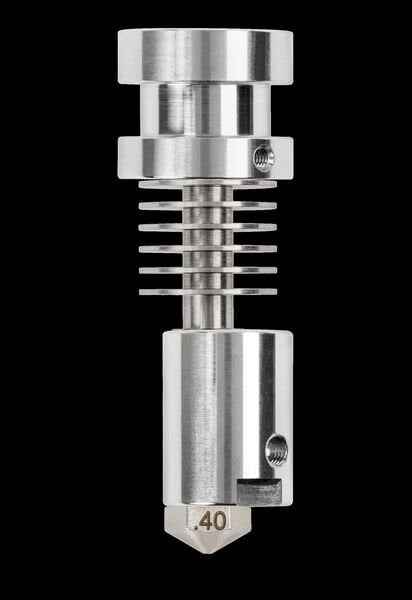![The very tiny Pico Hybrid 3D printer hot end [Source: Metaform]](https://fabbaloo.com/wp-content/uploads/2020/05/image-asset_img_5eb08bf000997.jpg)
The Pico Hybrid hot end has followed a torturous path, but it is finally available.
The history of the Pico Hybrid is one of the more fascinating sequences of events in 3D printing history. The story began way back in 2013, when a startup company called B3 Innovations ran a successful Kickstarter campaign to launch the original Pico hot end.
After that success, B3 Innovations began development of a new version, the Pico Hybrid. The device was developed up to a level able to support a beta test, and in 2016 the hot end was released to a number of testers. Their feedback was used to tune up the design of the Pico Hybrid.
But it was not released.
3D Printing Dipping Sauce Holders
It turns out a bizarre series of events caused B3 Innovations to suddenly pivot away from making an advanced 3D printer hot end to — and I’m not kidding here — dipping sauce holders. You can read the full story in our post that has my all-time favourite headline, “The Strange Tale of B3 Innovations Ends In Dipping Sauce”.
Was that the end of the Pico Hybrid? No, it turns out it was brought back to life.
Metaform Acquires Pico
A new venture, Missouri-based Metaform LLC negotiated with B3 Innovations to obtain the rights to both the Pico and Pico Hybrid hot ends from B3 Innovations, who I presume are still deep in the sauce and no longer had interest in hot ends. However, they say:
“B3 Innovations is actively working with Metaform through the launch of the Pico Hybrid to ensure a smooth transition.”
Now that we know the Pico Hybrid is available, why would you want one? Let’s take a look at this unusual component.
It is designed as an extremely lightweight hot end, being only 28g. This will assist achieving higher print quality as the hot end will have less momentum to overcome during sudden directional changes while 3D printing.
It’s called a hybrid hot end because it can be used for the two usual forms of 3D printing: low and high temperature.
Low and High Temperature 3D Printing
![Thermal simulation of the Pico Hybrid 3D printer hot end [Source: Metaform]](https://fabbaloo.com/wp-content/uploads/2020/05/image-asset_img_5eb08bf04e8e1.jpg)
Low temperature designs are required for certain materials, particularly TPU and other flexible materials that would stick to metal surfaces. For these materials you require a slippery PTFE tube to guide the filament into the hot zone.
However, for higher temperature materials PTFE would soften or even emit noxious particles, so all-metal hot ends are required. Usually this means you have to have two different types of hot ends on your device if you want to 3D print materials in these two categories.
How does the Pico Hybrid handle this dilemma? The Pico Hybrid can be swiftly changed from one to the other by simply swapping the nozzle.
![The Pico Hybrid 3D printer hot end assembly, pre-production rendering [Source: Metaform]](https://fabbaloo.com/wp-content/uploads/2020/05/image-asset_img_5eb08bf098ce6.jpg)
In the Pico Hybrid configuration, the nozzle includes a filament path guide attached to the top. The low temperature nozzles include a PTFE tube, while the high temperature nozzles include a metal guide. The rest of the hot end remains static regardless of which mode you are in.
The implications of the Pico Hybrid are that with a single extrusion device you could be able to 3D print both types of materials without much effort. You don’t have to swap out the entire hot end; you have only to change the nozzle to switch modes.
Pico Hybrid Availability
![The Pico Hybrid 3D printer hot end, pre-production rendering [Source: Metaform]](https://fabbaloo.com/wp-content/uploads/2020/05/image-asset_img_5eb08bf0d4383.jpg)
The Pico Hybrid was available for pre-order from Metaform, but they now intend on launching a new Kickstarter campaign, upcoming very soon.
The hot end is available in either 1.75mm or 3.00mm formats and 12V or 24V power. It’s to be priced near US$99, but it appears you’ll have to select a nozzle or two to go with it — because Metaform has no idea what your material printing intentions might be. This price will rise by US$20 after launch.
As there must be a 3D printer to attach the hot end, Metaform intends on offering a wide selection of mounting kits for different 3D printers.
An all-metal nozzle is priced at US$20, and brass PTFE nozzles are US$8. You can pick up a “Multi-Material Nozzle 3-Pack”, which includes a low temperature nozzle for flexible and PLA, a hardened nozzle for abrasive materials, and an all-metal nozzle for the rest.
The Pico Hybrid seems like a very flexible solution for those using single extrusion systems.
Via Metaform

